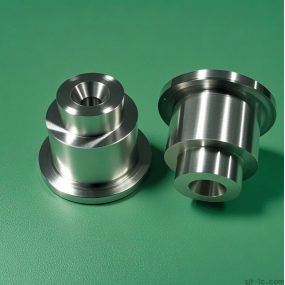Composition and structure of five axis linkage CNC Machining center
Most five axis linkage machining centers have a 3+2 structure, consisting of three linear motion axes (x, y, z) and two rotation axes (a, b, c) that rotate around the x, y, and z axes respectively.
In this way, from a broad perspective, there are x, y, z, a, b; x,y,z,a,c; x. Three forms: y, z, b, and c; Divided by the combination of two rotation axes, there are generally three forms: double turntable, turntable with pendulum head, and double pendulum head.
These three structural forms, due to physical reasons, respectively determine the size of the machine tool and the range of the machining object. Among them, the five axis linkage machine tool with a dual turntable structure is only suitable for processing small parts, such as small integral turbines, impellers, small precision molds, etc., because the workpiece needs to move in two rotational directions when processing the workpiece. Due to its simplest structure, it is relatively inexpensive. In terms of application, this is the most common type of five axis linkage CNC machine tool.
The five axis linkage machine tool with a turntable and a swing head structure can have various combinations to adapt to different processing objects. For example, when processing blades of a steam turbine generator, it is necessary to add an a-axis and a b-axis, where the a-axis needs to be supported by the top of the tailstock. If the workpiece is long and thin in diameter, it needs to be clamped at both ends and stretched for processing. Of course, a necessary condition here is that the two turntables must rotate strictly synchronously; For processing the parts shown in Figure 2, the c-axis and b-axis are used. Since the workpiece only rotates on the c-axis, it can be small or large, with a diameter range from tens of millimeters to thousands of millimeters. The diameter of the c-axis turntable can also range from 100-200mm to 2-3m, and the specifications and quality of the machine tool can range from a few tons to tens of tons or even tens of tons.
This is also a type of widely used five axis linkage CNC machine tool, which is priced in the middle and varies greatly in terms of random machine specifications, accuracy, and performance. The five axis linkage machine tool with a double pendulum head structure is shown in Figure 3. Due to the structure itself, there is usually an electric spindle with a tension knife structure in the middle of the pendulum head, so the size of the double pendulum head itself is not easy to make small, usually between 400-500mm.
Early double pendulum heads generally used worm gear structures with adjustable clearances or gear structures that could eliminate clearances. The performance of the machine (rigidity and precision) is often determined by the rigidity of the double pendulum head transmission chain, that is, the clearance of the transmission gear must be negative. The transmission gear works under a certain elastic deformation state, and the magnitude of its deformation depends on the preload of the transmission link. Figure 3 (a) shows a Spanish style double pendulum milling head, which adopts gear transmission and mouse tooth disc positioning structure, with much better rigidity than general double pendulum milling heads, and is particularly suitable for efficient machining of pentagons. The structure of the rotating shaft of relatively new five axis linkage machine tools generally adopts torque motors with so-called "zero transmission" technology, such as famous five axis linkage machining center product brands such as Mikron from Switzerland and DMG from Germany. The application of zero transmission technology in rotating shafts may be the most ideal technical route to solve the rigidity and accuracy of their transmission chains. With the development of technology, the manufacturing cost of torque motors has greatly decreased, and market prices have also declined. This process will greatly promote the manufacturing technology of five axis linkage machine tools.
The functions of a five axis machining center
Five axis linkage CNC machine tool is a high-tech and high-precision machine tool specifically designed for processing complex surfaces. This machine tool system has a significant impact on industries such as aviation, aerospace, military, scientific research, precision instruments, high-precision medical equipment, etc. in a country. Nowadays, it is widely believed that the five axis linkage CNC machine tool system is the only means to solve the machining of impellers, blades, marine propellers, heavy-duty generator rotors, steam turbine rotors, large diesel engine crankshafts, and so on.
Five axis machining centers are not only used in civil industries, such as wood mold manufacturing, bathroom trimming, automotive interior parts processing, foam mold processing, European style home furnishing, solid wood chairs, etc., but also widely used in aviation, aerospace, military, scientific research, precision equipment, high-precision medical equipment and other industries. Five axis machining center is a high-tech means that makes impossible possible, and all spatial surfaces and special-shaped machining can be completed and realized. It can not only complete the task of mechanized machining of complex workpieces, but also quickly improve machining efficiency and shorten the machining process.


 Spanish
Spanish Arabic
Arabic French
French Portuguese
Portuguese Belarusian
Belarusian Japanese
Japanese Russian
Russian Malay
Malay Icelandic
Icelandic Bulgarian
Bulgarian Azerbaijani
Azerbaijani Estonian
Estonian Irish
Irish Polish
Polish Persian
Persian Boolean
Boolean Danish
Danish German
German Filipino
Filipino Finnish
Finnish Korean
Korean Dutch
Dutch Galician
Galician Catalan
Catalan Czech
Czech Croatian
Croatian Latin
Latin Latvian
Latvian Romanian
Romanian Maltese
Maltese Macedonian
Macedonian Norwegian
Norwegian Swedish
Swedish Serbian
Serbian Slovak
Slovak Slovenian
Slovenian Swahili
Swahili Thai
Thai Turkish
Turkish Welsh
Welsh Urdu
Urdu Ukrainian
Ukrainian Greek
Greek Hungarian
Hungarian Italian
Italian Yiddish
Yiddish Indonesian
Indonesian Vietnamese
Vietnamese Haitian Creole
Haitian Creole Spanish Basque
Spanish Basque











